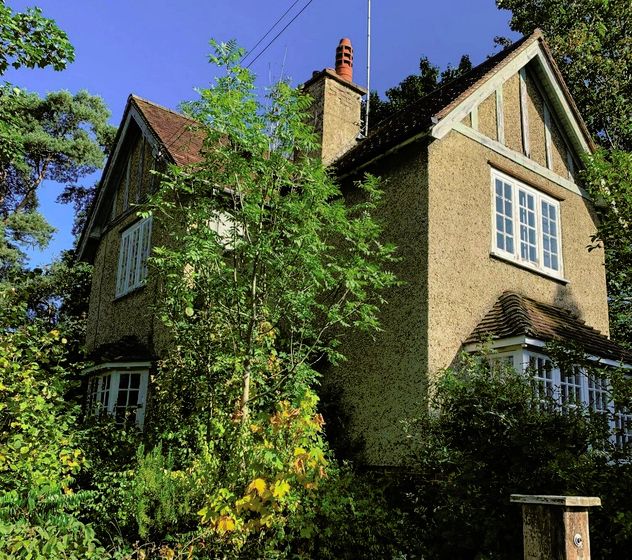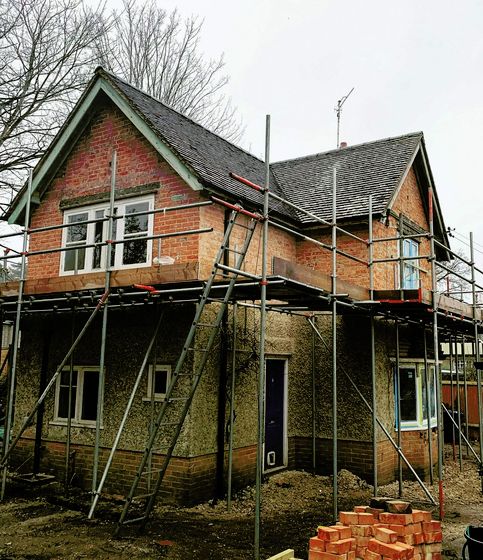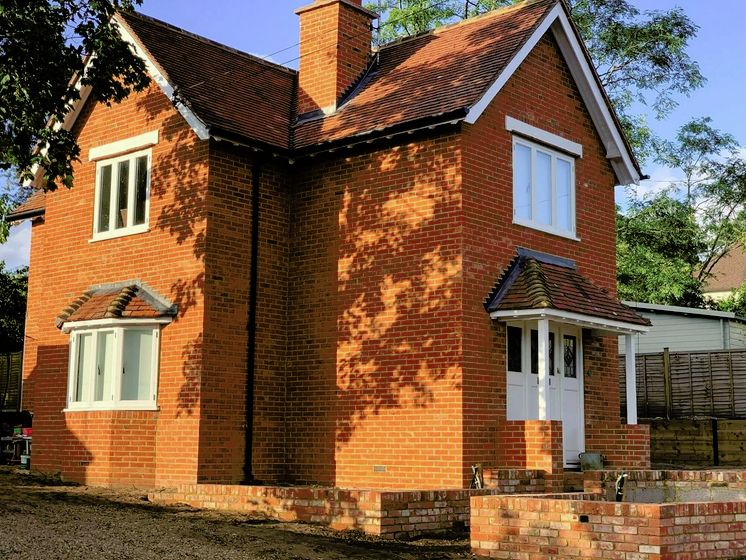The pebble dashed house has been popular since the 1920s, through the post-war housing boom of the 1960s and 1970s, offering a quick and low-cost way to weatherproof and disguise imperfect brickwork. However, today, many homeowners are removing pebbledash to reveal original brick façades, improve insulation options, or achieve a sleeker modern look.
What is pebbledash?
Pebbledash is an exterior render, or wall finish, created by throwing – or “dashing”– small stones or gravel onto a wet coat of sand-and-cement render. The stones are embedded and set in place, providing a rough texture which resists minor impacts and hides surface cracks. Unfortunately, the dense cement base can trap moisture, leading to damp problems in older homes.
Pebbledash typically lasts for between 20 and 40 years before it starts to crack and flake, exposing your walls to weather damage. This could result in costly renovations, which may make removing your pebbledash a good option in the long term.
Why are homeowners removing pebbledash?
There are several reasons why pebbledash is being removed from properties:
- Damp and breathability: Cement render can trap moisture against the walls. Removing pebbledash allows masonry to breathe, dries out internal plaster, and creates a sound base for modern breathable insulation.
- Upgrades and maintenance: Exposed brick or a new thin-coat render applied after removing the pebbledash provides a smoother, lower-maintenance surface that’s easier to insulate, paint, or refinish in contemporary colours.
- Kerb appeal: In older properties, handsome brickwork often lies beneath the render, and once exposed, can raise resale value and make a period home feel authentic again.
Case study: Pebbledash removal on a 1920s house
How to remove pebbledash
Removing pebbledash requires expertise and the right tools, making it a job best left to professionals. While you can chip away at the render with a hammer and chisel, this is time-consuming and can result in broken brickwork or even structural damage. As a result, your home insurance may be invalidated.
Fortunately, many FMB members have the required professional expertise and tools to remove your render quickly and cleanly.
Sandblasting bricks
Once the bulk of the pebbledash has gone, stubborn cement nibs remain on the wall. Sandblasting bricks can clean these quickly, but it’s often not recommended, as it can be too aggressive. Its use can result in the erosion of common London stock and soft clay bricks, as well as open mortar joints, which can invite frost or salt damage.
Low-pressure blasting with recycled glass or another softer medium is often a better option.
In conservation areas or on listed houses, abrasive blasting often requires prior consent and is routinely refused unless you prove a gentler alternative won’t work.
Repointing brickwork
After blasting to remove the last bits of pebbledash, it’s often necessary to repoint the brickwork, addressing any damaged or missing mortar and ensuring the property’s structural integrity.
Alternatives to removing pebbledash
There are several alternatives to removing pebbledash. Let's talke a look:
1. Render over pebbledash
Rendering over pebbledash costs less than complete removal and repointing, yet still delivers a sleek, contemporary façade. Not all properties are suitable for this approach, as it can add unnecessary stress to your walls.
Two main options exist if you want to render over pebbledash:
- Thin-coat renders: These are flexible enough to accommodate slight movement in the wall, so hairline cracks are far less likely to appear. Being vapour-permeable, they allow walls to breathe, minimising the damp risk.
- Thick-coat renders: These renders don’t flex or breathe well, but are sturdier than the thin-coated options.
If you decide to go for a rendered finish, you can find out more about the right materials to choose with the FMB's useful guide to house render.
2. Painting pebbledash
Some homeowners like the textured cottage look, but want a cleaner, brighter colour. Paint bridges hairline cracks and simplifies future maintenance, though the surface will trap dirt faster than a flat render.
The best way to paint pebbledash is by using a long-pile roller or a brush in a dabbing or stippling motion, ensuring the paint reaches all the crevices, or by spray painting. It’s crucial to use a waterproof breathable masonry paint, which allows rain to be repelled while letting moisture escape. Several coats may be necessary to achieve the desired result.
3. Repairing pebbledash
If your pebbledash has cracked and is flaking, repairs are possible. A repair is a cheaper option than complete removal or resurfacing; however, it often results in a mismatched appearance, which can require painting to create a cohesive look.
Insulating pebbledash walls
Pebbledash walls can be insulated, although this can be more challenging than smooth rendered walls.
Injecting cavity wall insulation through drilled holes without stripping the render is possible, provided a damp-risk check confirms the pebbledash is sound and the cavity is clear. If the dash is too uneven or the wall is solid and can take the extra stress, a better route is external wall insulation. Rigid thermal boards are attached through the render and finished with a new mesh-reinforced render, giving both thermal uplift and a fresh façade in one job.
When it comes to insulation, it pays to do your research to help avoid common issues such as damp and mould. Take a look at our ultimate guide to house insulation for more information.
The cost of removing pebbledash
The cost to remove pebbledash from your home will vary, depending on your location in the UK, as well the property size, access conditions and how much repair work is needed to the bricks beneath. We recommend getting at least three quotes from local builders – enter your postcode below to start your search.
Once you're on the way to getting some quotes, check out our guide to working with your builder to make sure you're on the same page.
Whether you want bare brick, fresh render or an insulated home, pebbledash removal can provide a wall that breathes, performs, and looks far better than it did before.



